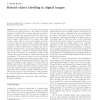Free Online Productivity Tools
i2Speak
i2Symbol
i2OCR
iTex2Img
iWeb2Print
iWeb2Shot
i2Type
iPdf2Split
iPdf2Merge
i2Bopomofo
i2Arabic
i2Style
i2Image
i2PDF
iLatex2Rtf
Sci2ools
MVA
2007
2007
Hybrid object labelling in digital images
The application of a technique for labelling connected components based on the classical recursive technique is studied. The recursive approach permits labelling, counting, and characterizing objects with a single pass. Its main drawback lays on its very nature: Big objects require a high number of recursive calls, which require a large stack to store local variables and register values. Thus the risk of stack overflow imposes an unpractical limit on image size. The hybrid alternative combines recursion with iterative scanning and can be directly substituted into any program already using the recursive technique. I show how this alternative drastically reduces the number of consecutive recursive calls, and thus the required stack size, while improving overall performance. The method is tested on sets of uniform random binary images and binary images with a random distribution of overlapping square blocks. These test sets provide insight on the adequacy of the algorithm for different ...
Classical Recursive Technique | Computer Vision | MVA 2007 | Recursive Calls | Recursive Technique |
| Added | 27 Dec 2010 |
| Updated | 27 Dec 2010 |
| Type | Journal |
| Year | 2007 |
| Where | MVA |
| Authors | Julio Martín-Herrero |
Comments (0)

